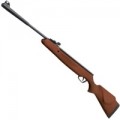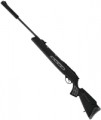Muzzle velocity
The muzzle velocity provided by the rifle - that is, the speed of the bullet as it exits the barrel.
All other things being equal, a higher bullet speed provides greater range and accuracy, and also simplifies aiming at long distances: the bullet flies along a smoother trajectory and requires fewer adjustments in height, and the influence of side winds decreases with increasing speed. On the other hand, this indicator directly affects the price of the rifle; and in some countries, legal restrictions on the ownership of pneumatic weapons are also related to the muzzle velocity of the bullet.
As for specific values, in the weakest modern rifles the initial speed does not exceed
150 m/s, and in the most powerful it can be
300 - 350 m/s or even
more(remember, the speed of sound is 330 m/s). In general, for recreational shooting at short distances, this parameter is not particularly important, and detailed recommendations for choosing pneumatics for more specific situations can be found in special sources. Let us only note that in AEG electric drives (see “Type”) the initial speed extremely rarely exceeds 150 m/s, but this is done solely for safety reasons: such “weapons” are intended for military-tactical games and initially involve shooting at people, and the high speed would be unsafe for players even with protective equipment.
It is also wor
...th considering that this indicator is not strictly defined. In any type of pneumatic it depends on the weight of the bullet (the lighter the faster); therefore, in the characteristics it is usually customary to indicate a certain average velocity for standard ammunition (usually weighing 0.5 g, in AEG - 0.2 g). In addition, in multi-compression rifles the actual speed of the bullet is determined by the degree of inflation, in gas-cylinder rifles it is determined by the ambient temperature, and in PCP models it is possible to achieve higher speeds than declared by replacing the air with a special gas (for example, helium). Nevertheless, this characteristic makes it possible to evaluate the capabilities of the rifle and compare it with other models, including those that differ in type.Muzzle energy
The muzzle energy provided by the rifle.
Muzzle energy is the kinetic energy of the bullet at the exit from the barrel. This energy, in turn, depends on two factors: the mass and the muzzle velocity of the bullet. Thus, this indicator directly describes the overall power of the rifle: higher muzzle energy allows you to effectively fire at longer distances and/or heavier ammunition. On the other hand, an increase in power accordingly affects the cost of weapons.
Note that muzzle energy can be grounds for legal restrictions on the purchase/use of pneumatics. So, in some countries in the post-Soviet space, the maximum value allowed for freely sold rifles is
7.5 J — a special permit will be required to purchase more powerful weapons. And most freely sold rifles in such regions have a power of the
order of 3 – 5 J. Such legal restrictions should be clarified separately. Lower rates are found mainly among “soft” pneumatics for airsoft (airsoft), using 6 mm plastic balls. For such models, a value of more than 2 J is already considered very solid, and in games such rifles are used with a minimum distance limit — for example, 15 m or 20 m (so that a shot from too close a distance does not injure the player).
It is also worth saying that the claimed characteristics of air rifles may, at first glance, not correspond to physical calculations. For example, for a model for the same 7.5 J
..., the initial speed of 250 m/s can be claimed in the characteristics; for a 4.5 mm bullet weighing 0.5 g (the average, most popular weight), this would correspond to an energy of as much as 15.6 J. However, there are no inconsistencies here: such characteristics mean that the muzzle velocity was measured for a lighter bullet (for example, 0 .2 g), which accelerates more strongly at the outlet of the barrel. Accordingly, with heavier ammunition, the speed will be lower; it can be determined using special formulas or online calculators.Scope mount
The type of mount for mounting sights provided in the design of the rifle. Most often in such cases we are talking about an optical or collimator sight; and the most popular mounting options are
Weaver/Picatinny rail and
dovetail. Here are their features:
— "Dovetail". This type of mount has a cross-sectional view of an inverted trapezoid (expanding upwards); the clamp on the sight covers this trapezoid from two sides, and the transverse cutouts, unlike the Weaver / Picatinny rails, are not provided for in the design — fixing in place is carried out in other ways. Dovetail mounts were originally used in civilian hunting rifles, as well as in Soviet-style military weapons. Nowadays, due to their simplicity, low cost and versatility, they are extremely common in air rifles. In addition, we note that you can even install a Weaver / Picatinny rail on a dovetail (such rails are available separately) and use a sight with the appropriate type of mount.
— Weaver / Picatinny rail. Fastening in the form of a bar with a T-shaped profile and characteristic transverse slots — they serve to rigidly fix the installed accessories in one place. Technically, Weaver and Picatinny rails are different types of mounts, they differ in the size of the slots; these differences are such that the sights and other “body kit” for the Weaver rails easily get on the Picatinny rail, but the opposite option is far fro
...m always possible. However, in the civilian market, most weapon accessories for such slats are made specifically for the weaver, so this nuance, most often, is not fundamental, and both types of slats are combined into one category.
In general, for a number of reasons, such straps are much less common in air rifles than the dovetail. At the same time, classic pneumatics are most often equipped with Weaver mounts, but in airsoft copies of real weapons, Picatinny rails (or compatible NATO STANAG 4694 rails, also known as RIS 22 mm) can also be used.
— Is absent. The absence of any standard mounts for the sight in the design of the rifle. Most often, this designation means that the rifle is equipped with a classic front sight with a whole and does not require the installation of additional sights. However, there is also a more specific option — pneumatics, in which original mounts are used to install optics or a collimator, which are not related to the standards described above. Such rifles can be supplied with or without scopes; there are even models with non-removable optics, although extremely rare.Swivels
The presence in the design of the rifle
sling swivels — special loops or staples (usually metal) on which the weapon belt is attached. There are usually two such loops — in the front and back of the weapon. In this case, most often the swivels are installed on the underside of the butt and forearm; this design is universal, it allows both right-handed and left-handed people to use the belt with the same comfort. There are also models with a lateral location of the front swivel — usually on the left side of the forearm, under the right-handed hold; however, nowadays in such rifles it is often possible to rearrange the swivel to the other side. So if the pneumatic is bought for a left-hander and it is planned to equip it with a belt, it will not hurt to clarify the features of the sling swivels separately, however, most likely, their design will not create inconvenience.
Barrel length
The working length of the rifle barrel is from the chamber where the bullet is loaded to the muzzle. The shortest barrels found nowadays have a length
of just over 200 mm(and in some AEGs even
less than this value); the longest reach
500 – 600 mm.
There is a stereotype that the muzzle velocity directly depends on the length of the barrel. In firearms, this is true — but not in pneumatics. Firstly, in such rifles, the initial velocity depends on a number of other indicators — pressure, the quality of the barrel treatment, the efficiency of the valves, etc. on the first 20 – 25 cm of the barrel, then the gas pressure drops noticeably. The exception is PCP rifles, in which the longer barrel really makes it easier to achieve high speeds. However, again, so many additional factors affect the final result that models with the same barrel length can differ markedly in initial speed.
The second common stereotype is that a longer barrel improves accuracy and accuracy. This is true in the context that a longer barrel allows for a greater distance between the front and rear sights, making it easier to aim carefully. Technical accuracy does not depend on the length, but on the quality of the barrel processing.
Summing up all of the above, we can say that the length of the barrel for an air rifle is more of a reference than a really significant paramete
...r, and when choosing, it is better to focus on more "close to life" characteristics — first of all, directly claimed muzzle velocity.Stock material
—
Tree. A classic material used in firearms and then pneumatic weapons since ancient times (in fact, since its inception). Wooden stocks are strong enough on their own, and in modern rifles they are also amenable to special treatment to protect against dampness, temperature changes, etc .; while the rifles have a nice appearance in a classic style. At the same time, the wood is prone to abrasion, scratches easily appear on it, and there is a possibility of cracks. When used in simple conditions, such as periodic "shooting" in the country, this does not matter, however, for example, a wooden stock is not suitable for hunting — at least because it will quickly lose its "presentation". At the same time, this material is also somewhat more expensive and more difficult to process than plastic that is more resistant to “troubles”. Therefore, today the tree is used mainly in pneumatics of the middle and upper price range and is designed for those who are primarily interested in the aesthetics of weapons.
—
Plastic. One of the most popular materials for the manufacture of modern pneumatics. Such stocks are easy to manufacture and inexpensive, while the plastic can be given a rather complex shape without any problems, which, in particular, facilitates the installation of various adjustment systems (see “Cheek Adjustment”, “Butt / Stock Adjustment”). However, its main advantage is practicality: this materia
...l is resistant to impacts, cracks and scratches, comparable in strength to wood (or even superior) and has a small weight. As a result, plastic has become widespread in almost all price ranges.
— Aluminium. A fairly advanced material that combines low weight and high strength. On the other hand, aluminium stocks for classic pneumatics are generally expensive, and therefore are used mainly in high-end professional models (although there are exceptions). But in airsoft rifles that copy real weapons, the situation is somewhat different: there aluminium can be used as a simpler and more affordable alternative to steel (from which gunshot prototypes are made).
